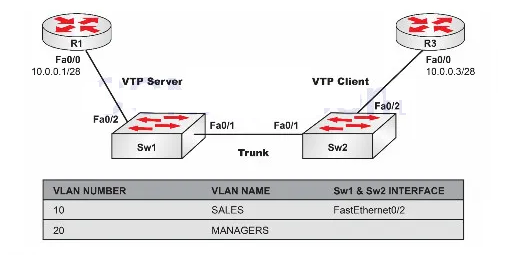Lab Objective:
The objective of this lab exercise is for you to learn and understand how to configure VTP server and client modes on Cisco Catalyst Switches. By default, all Cisco switches are VTP server devices.
Lab Purpose:
Configuring VTP client and server modes is a fundamental skill. VLANs are configured on VTP servers and VTP clients receive VLAN information from the VTP servers in the same VTP domain. VLAN sharing is possible by using a trunk between the switches. As a Cisco engineer, as well as in the Cisco CCNA exam, you will be expected to know how to configure VTP client and server modes.
Certification Level:
This lab is suitable for both CCENT and CCNA certification exam preparation.
Lab Difficulty:
This lab has a difficulty rating of 5/10.
Readiness Assessment:
When you are ready for your certification exam, you should complete this lab in no more than 15 minutes.
Lab Topology:
Please use the following topology to complete this lab exercise:

Task 1:
In preparation for VLAN configuration, configure a hostname on the switches and routers as depicted in the topology. Keep in mind that the default mode of operation of Cisco Catalyst Switches is VTP server mode. Remember to use a crossover cable between the switches.
Task 2:
Configure and verify Sw1 as a VTP server switch and configure Sw2 as a VTP client switch. Both switches should be in the VTP domain named CISCO.
Task 3:
Configure and verify FastEthernet0/1 between Sw1 and Sw2 as an 802.1Q trunk.
Task 4:
Configure and verify VLANs 10 and 20 on Sw1 with the names provided above. Assign FastEthernet0/2 on both Sw1 and Sw2 to VLAN10. This interface should be configured as an access port.
Task 5:
Configure R1 and R3 FastEthernet0/0 interfaces with the IP addresses 10.0.0.1/28 and 10.0.0.3/28, respectively. Test connectivity via your VLANs by pinging R1 from R3, and vice versa.
Configuration and Verification
Task 1:
Switch#config t Enter configuration commands, one per line. End with CTRL/Z. Switch(config)#hostname Sw1 Sw1(config)# Switch#config t Enter configuration commands, one per line. End with CTRL/Z. Switch(config)#hostname Sw2 Sw1(config)# Router#config t Enter configuration commands, one per line. End with CTRL/Z. Router(config)#hostname R1 R1(config)# Router#config t Enter configuration commands, one per line. End with CTRL/Z. Router(config)#hostname R3 R3(config)#
Task 2:
NOTE: By default, Cisco switches are VTP servers so no configuration is necessary for server mode on Sw1. This can be verified using the show vtp status command. However, you do need to configure the domain.
Sw1#config t Enter configuration commands, one per line. End with CTRL/Z. Sw1(config)#vtp domain CISCO Changing VTP domain name from Null to CISCO Sw1(config)# Sw2#config t Enter configuration commands, one per line. End with CTRL/Z. Sw2(config)#vtp mode client Setting device to VTP CLIENT mode. Sw2(config)#vtp domain CISCO Changing VTP domain name from Null to CISCO Sw2(config)#end Sw2#show vtp status VTP Version : 2 Configuration Revision : 0 Maximum VLANs supported locally : 250 Number of existing VLANs : 5 VTP Operating Mode : Client VTP Domain Name : CISCO VTP Pruning Mode : Enabled VTP V2 Mode : Disabled VTP Traps Generation : Disabled MD5 digest : 0x9D 0x1A 0x9D 0x16 0x9E 0xD1 0x38 0x59 Configuration last modified by 0.0.0.0 at 3-1-93 01:42:39
Task 3:
NOTE: Some Cisco switches default to 802.1q trunking so no explicit configuration is required. The 2960 Switch (used in the exam) is set to dynamic auto so you will have to set at least one side to trunk.
Sw1#show int f0/1 switchport
Name: Fa0/1
Switchport: Enabled
Administrative Mode: dynamic auto
Operational Mode: static access
Administrative Trunking Encapsulation: dot1q
Operational Trunking Encapsulation: native
Negotiation of Trunking: On
Sw1#config t
Enter configuration commands, one per line. End with CTRL/Z.
Sw1(config)#interface fastethernet0/1
Sw1(config-if)#switchport mode trunk
Sw1#show interfaces trunk
Port Mode Encapsulation Status Native vlan
Fa0/1 on 802.1q trunking 1
Port Vlans allowed on trunk
Fa0/1 1-1005
Port Vlans allowed and active in management domain
Fa0/1 1
Port Vlans in spanning tree forwarding state and not pruned
Fa0/1 1Task 4:
Sw1#config t Enter configuration commands, one per line. End with CTRL/Z. Sw1(config)#vlan10 Sw1(config-vlan)#name SALES Sw1(config-vlan)#exit Sw1(config)#vlan20 Sw1(config-vlan)#name MANAGERS Sw1(config-vlan)#exit Sw1(config)#interface fastethernet0/2 Sw1(config-if)#switchport mode access Sw1(config-if)#switchport access vlan10 Sw1(config-if)#end Sw1# Sw1#show vlan brief VLAN Name Status Ports ---- ----------------------- --------- ------------------------------- 1 default active Fa0/3, Fa0/4, Fa0/5, Fa0/6
Fa0/7, Fa0/8, Fa0/9, Fa0/10
Fa0/11, Fa0/12, Fa0/13, Fa0/14
Fa0/15, Fa0/16, Fa0/17, Fa0/18
Fa0/19, Fa0/20, Fa0/21, Fa0/22
Fa0/23, Fa0/24, Gig0/1, Gig0/2
10 SALES active Fa0/2
20 MANAGERS active
1002 fddi-default active
1003 token-ring-default active
1004 fddinet-default active
1005 trnet-default active
Sw1#
Sw2#config t
Enter configuration commands, one per line. End with CTRL/Z.
Sw2(config)#interface fastethernet0/2
Sw2(config-if)#switchport mode access
Sw2(config-if)#switchport access vlan10
Sw2(config-if)#end
Sw2#
Sw2#show vlan brief
VLAN Name Status Ports
---- ----------------------- --------- -------------------------------
1 default active Fa0/3, Fa0/4, Fa0/5, Fa0/6
Fa0/7, Fa0/8, Fa0/9, Fa0/10
Fa0/11, Fa0/12, Fa0/13, Fa0/14
Fa0/15, Fa0/16, Fa0/17, Fa0/18
Fa0/19, Fa0/20, Fa0/21, Fa0/22
Fa0/23, Fa0/24, Gig0/1, Gig0/2
10 SALES active Fa0/2
20 MANAGERS active
1002 fddi-default active
1003 token-ring-default active
1004 fddinet-default active
1005 trnet-default activeTask 5:
R1#config t Enter configuration commands, one per line. End with CTRL/Z. R1(config)#interface fastethernet0/0 R1(config-if)#ip address 10.0.0.1 255.255.255.240 R1(config-if)#no shutdown R1(config-if)#end R1#
R3#config t Enter configuration commands, one per line. End with CTRL/Z. R3(config)#interface fastethernet0/0 R3(config-if)#ip address 10.0.0.3 255.255.255.240 R3(config-if)#no shutdown R3(config-if)#end R3# R1#show ip interface brief Interface IP-Address OK? Method Status Protocol FastEthernet0/0 10.0.0.1 YES manual up up R1#ping 10.0.0.3 Type escape sequence to abort. Sending 5, 100-byte ICMP Echos to 10.0.0.3, timeout is 2 seconds: .!!!! Success rate is 80 percent (4/5), round-trip min/avg/max = 1/3/4 ms
NOTE: The first ping packet times out due to ARP resolution. Subsequent packets will be successful.
R3#show ip interface brief Interface IP-Address OK? Method Status Protocol FastEthernet0/0 10.0.0.3 YES manual up up R3#ping 10.0.0.1 Type escape sequence to abort. Sending 5, 100-byte ICMP Echos to 10.0.0.1, timeout is 2 seconds: !!!!! Success rate is 100 percent (5/5), round-trip min/avg/max = 1/3/4 ms
